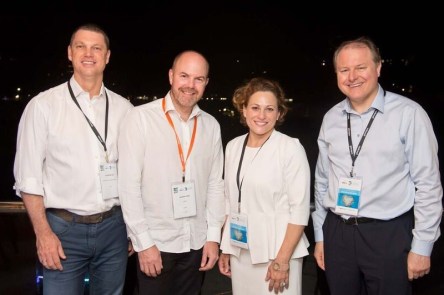When Hurricane Irma devastated a string of Caribbean islands and loomed off the coast of Florida, it had been less than two weeks since Hurricane Harvey made landfall in southeast Texas, displacing thousands of people from their homes. Irma was the strongest Atlantic basin hurricane ever recorded. It triggered evacuation orders for 5.6 million people and made two landfalls before being downgraded to a tropical storm on Monday, September 11. For a second time this summer, our team members mobilized for a natural disaster response. Having recently created a housing website to help those affected by Harvey find temporary and permanent homes, we used this experience to quickly launch another dedicated housing registry to assist residents displaced by Irma. Leveraging our RENTCafé property marketing and leasing platform, RentCafe.com/HurricaneIrma allows displaced residents to find new housing. It also makes it possible for housing providers with properties in the affected and surrounding areas to quickly and easily list available units, some with special concessions. There is no charge for companies to list their properties on the website or for residents to use it. There is also a toll-free hotline that evacuees can call seeking housing assistance if internet is not available. The hotline can be reached at (844) 363-6317. With many clients in the affected areas, we’re offering disaster response assistance for clients affected by either hurricane, including additional program support and tools to help clients communicate with their residents during the aftermath. Taking care of our clients is a critical part of the Yardi mission statement, and representatives are reaching out now to offer these and other services at no charge. “The best-case scenario for everyone is that our disaster response efforts remain untested, but we have them in place so that we can aid...
Up to Bat
Cricket Expands in US
Pennsylvania-based Global Sports Ventures plans to introduce eight professional cricket teams to the United States. Each team will have its own stadium complex as part of a three-year initiative to solidify the sport’s presence in the country. To Jay Pandya, chairman of Global Sports Ventures, the U.S. is the next natural frontier for cricket. The sport has a growing and passionate fan base. More than 1 million viewers watched the live broadcast of the 2015 World Cup. That same year, an exhibition series touring Los Angeles, Houston, and New York attracted audiences averaging 28,000 viewers. “We, as Americans, look for new things and grow into different fields. People don’t realize that cricket was partially born in the U.S. The first international game was played between the U.S. and Canada in New York. The 1844 game, played in Bloomingdale Park in Manhattan was one of the earliest international games on record,” Pandya explains in an interview. Possible stadium sites include Atlanta, New York, San Francisco, Chicago, Dallas, Orlando, Washington, D.C. and East Brunswick, New Jersey. These markets were chosen, in part, for their large Asian populations according to an article on Bisnow.com. “When you have people of South Asian descent who really understand cricket, it helps. But after that it will probably go mainstream with Americans. I believe that will be very quick, because, as Americans, we just love sports. [And] it doesn’t matter what kind of sport,” says Pandya. To jump start the plan, Global Sports Ventures entered a $70 million licensing agreement with the USA Cricket Association (USCA). More than 32,000 cricket players are registered with the USCA and may become members of the future teams. There are also several smaller organizations throughout the nation that may serve as sources of talent and...
Facebook Live
5 Tips to Rock Live Video
Video continues to rise to the top of the digital marketing playbook. If you’re skeptical about the power of video, consider that almost 50% of internet users look for videos related to a product or service before visiting a store. And four times as many customers would rather watch a video about a product than read about it. Video content can also improve SEO, increase engagement and boost brand loyalty and awareness. Within the realm of real estate, the industry – from retail to residential to student housing – is finding creative ways to leverage video. What’s clear is video isn’t going anywhere, so it’s time to jump in feet first. Facebook Live offers an interactive, free and highly visible way to engage with an audience. The platform now sees 8 billion average daily video views from 500 million users. With help from social media experts, in-depth tutorials and best practice tips, even the most novice user can become a Facebook Live pro. Here are five tips to rock Facebook Live: Step 1: Ask permission If you plan to live stream other people, ask for permission before you record them. Keep in mind some conferences and venues may have strict no streaming policies. When in doubt, ask. Step 2: Game plan Some questions to inform your live video strategy: Why do you want to do live video? Who are you hoping to reach? What do you want this audience to do? What will you talk about? How long will you go live for? Facebook recommends 10 to 90 minutes, but even 5 minutes is great. Do what feels right for your organization and your viewers. Where will you go live from? Walk the room and consider reserving a spot in front. Minimal background...
Canada in Focus
Retaining condo corporations
If you are a condominium property manager, every day you work towards maintaining your properties to make them desirable places to live, while keeping operations running smoothly. Further, you must ensure the properties meet the expectations of owners and condo corporations. In competitive markets such as Toronto and Vancouver, this is especially key. According to the experts, the lack of single-family residential unit supply in the current Canadian market is expected to create opportunities for condo markets to absorb excess demand. Condo demand is forecast to increase in Toronto and Vancouver, due to factors including urban migration and the interest of foreign real estate investors. In addition, rising house prices, which have reached 4.6 times the national average household income, further powers the condo market. Given the high demand and potential growth in this industry, it is crucial to stand out as a property manager. Following are some tips to help you attract and retain condo corporations and at the same time reduce your overhead costs and streamline your operations. Enhance Your Digital Presence It all starts with branding. In today’s world, it is imperative to have a digital presence in order to establish credibility of your business and to attract prospective customers. When it comes to your property management brand, curb appeal matters. Critical first impressions often happen online. Creating a beautiful property website with rich, easy-to-use features including an owner portal will further heighten your brand value and make you a more valued property management service provider. Creating a Community Due to the growth in demand in the condo property market, creating, promoting and maintaining a strong sense of community is crucial to stand out as a property manager. Of course, property appeal goes beyond landscaping and renovations. Today’s owners are looking...
Every Watt Counts
Benchmarking in the Big Apple
On December 28, 2009, New York City Mayor Michael Bloomberg signed Local Law 84 (LL84), mandating annual energy reports for any privately owned buildings over 50,000 square feet. (In October 2016, the city expanded LL84 and LL88 to include buildings 25,000 Sq. Ft. and higher, though, this doesn’t officially go into effect until 2018.) Enacted as part of the city’s Greener, Greater Buildings Plan (GGBP), LL84 was designed to help building owners not just measure energy use, but to develop actionable energy efficiency strategies based on that data. By the time the first benchmarking report was released in 2012, the city had gathered energy usage information from 1.8 million square feet of commercial and residential space, making it one of the largest accumulations of benchmarking data gathered for a single jurisdiction. “Buildings account for 75 percent of all greenhouse gas emissions in New York City, yet many property owners and managers do not know they [can] be a part of the solution and save money by making their buildings more energy efficient,” said Mayor Bloomberg in a statement after the first benchmarking reports were released in 2012. “This benchmarking report will help us understand where we can act most quickly to significantly reduce GHG emissions and achieve our PlaNYC goals.” Lights, Meters, Action Often considered the low-hanging fruit of energy efficiency implementation, improving a building’s lighting system can dramatically reduce energy consumption. In New York City, roughly 18% of energy use in non-residential buildings can be attributed to lighting, which also accounts for 18% of the city’s carbon emissions. With the goal of reducing greenhouse gas emissions by 30% within the next 15 years, Local Law 88 (LL88) was designed to address the need to encourage lighting upgrades for improved energy efficiency and reduced...
NewRiver REIT
UK client interview
The British retail investment market joins the rest of the United Kingdom’s business community in facing a host of unknowns in 2017. Chief among them is the timing and impact of the UK’s exit from the European Union following the outcome of the referendum in June 2016. Yardi caught up with one its partners, NewRiver REIT, a specialist retail and leisure investor, asset manager and developer whose convenience-led positioning means it is uniquely placed to navigate these uncertain times. NewRiver’s £1.3 billion portfolio includes 33 community shopping centres, 22 retail parks, 16 high street assets and 350 pubs. The portfolio provides consumers up and down the UK with its daily essentials – those items essential to daily life, the things consumers require, opposed to what they simply desire. Fundamental to the success of the business over the past seven and half years has been how NewRiver has engaged with and satisfied all the stakeholders within its chain, from store customers, retailers, peers, advisors and local authorities all the way to its institutional investors and shareholders. “At the heart of the retail sector is the customer and our business begins with building and retaining consumer loyalty,” says Emma Mackenzie, a Director at NewRiver who manages assets in Scotland, Northern Ireland and the north-east of England. “At the local level, we make sure our shopping centres satisfy the needs of the towns they serve. Its about providing a variety of products and services at a price the customer can afford. Furthermore, we work hard to ensure the environment is fit for purpose – and that includes such basic factors as the centre being clean and accessible as well as bright and attractive and providing somewhere to sit down or get a cup of tea.” Brexit has triggered...
Top Office Deals
2016 Transaction Recap
The U.S. commercial real estate market took something of a respite in 2016, during a year characterized by political volatility. Compared to the previous year, when the market fired on all cylinders, office players were more cautious in 2016, with leasing and sales activity cooling down to more sustainable levels, per most industry reports. Office tenants were reluctant to make any major moves pending the conclusion of the presidential election, thus lease renewals and consolidations took the stage in the past year. Though office sales activity also decreased 7% year-over-year, according to Colliers, the national transaction volume was still the fourth-highest yearly total in the past 15 years, reaching $140.5 billion. We enlisted the help of Yardi Matrix sales data to round up a list of the 50 largest office deals of 2016. The results of our analysis aren’t all that surprising: the New York City office investment market remains the most attractive destination for both local and offshore buyers, though other markets also landed a good deal of capital in the past year. The U.S. office market is poised to become even more attractive in the future, especially to foreign investors, if Brexit goes through. Check out the list of the top 50 largest office deals of 2016 on the CommercialCafe blog. NYC Home to Largest Single-Asset Sale of the Year The priciest office transaction in New York City and the second-largest overall office deal of the year was the $1.93 billion sale of the AXA Equitable Center at 787 Seventh Avenue in Manhattan. One of the biggest investments in pension fund CalPERS’ history, the sale closed Jan. 27, 2016, at $1,179 per square foot. The 51-story, 1.6 million-square-foot tower is LEED certified and includes 49,000 square feet of retail space, a parking garage and access to the underground concourse of Rockefeller Center. CalPERS bought the...
Tallest Passive House...
Cornell Tech Tower
New York will soon boast the world’s tallest passive house building. Cornell Tech tower will break international records and set a new standard sustainable building. Cornell Tech residential tower is a collaboration between Yardi client Related Companies, Hudson Companies, and Cornell Univerty. The residential high-rise broke ground in 2015. Upon completion this fall, it will stand 26 stories high and cover 270,000 square feet. It houses 356 rentals with floor plans ranging from studios to three-bedroom suites. Amenities include a rooftop deck with city views, a lounge, gym, and bike room. To promote an atmosphere of learning, the site hosts numerous public spaces. These tech-ready meeting rooms encourage interaction between faculty and students. The residential towers provide easy access to the East River tram and metropolitan subway. Both connect to Manhattan and its transit hubs. Cornell Tech residential tower will be the tallest Passive House building in the world. The Passive House, or passivhaus, design concept originated in Germany. It is a performance-based standard without dictated methods of construction. Passive cooling techniques such as strategic shading, air circulation and ventilation techniques keep buildings comfortable in warm weather. In cool weather, the buildings make efficient use of the sun, insulation, internal heat sources and heat recovery. Passive House buildings rely less (or none at all) on conventional heating and cooling systems. Internationally, Passive House designs can operate using 60-90% less energy than conventional buildings. “In thinking through the right type of building for a campus that honors innovation, one of the first things we came up with was Passive House construction, which could be a game-changer for the residential industry,” says David Kramer, a principal at Hudson Companies during an interview with Planning Report. It was after touring several large Passive House projects in Vienna...
Build-to-Rent
UK Real Estate Evolves
GREAT BRITAIN (March, 2017) – It is no longer about landlords; today’s property managers recognise that happy residents are at the heart of any successful scheme. Yardi invited a panel of experts in Leeds – a ‘northern powerhouse’ city heavily invested in cutting edge build-to-rent development – to discuss the rapidly-evolving sector Graham Bates – Founder and chief executive – LIV Group Jonathan Pitt – National director, corporate PRS and build-to-rent, Countrywide Joanne Pollard – Director – Five Nine Living, Fresh Student Living Andrew Wells – Partner and non-executive chairman – Allsop Letting & Management (Interviewer) Claer Barrett – Personal finance editor – Financial Times (chair) What is the biggest challenge for the build-to-rent sector? Joanne: There are three main challenges. Firstly, there’s not enough stock. Everyone wants to pile in from an investment perspective – and if you want to buy assets producing rents, that’s a challenge. Secondly, we’re all learning about this together. There are new practices and we need to find the best ones. And finally, costs. How much of a premium are people prepared to pay? Jonathan: I agree – the big challenge is where the private rented sector (PRS) sits in the market. What is the premium people will pay to live in a well-run building with amenities? And what about mid-market level? Graham: PRS is not the right label. What we do is build-to-rent. The private rented sector as a whole includes buy-to-let. We are a segment of PRS but what makes us different is that we are building for long-term rental. We are starting to see what I call ‘live learning’. As this sector started to take off, people talked about what might happen. Now we’ve got people living in buildings. We have data. We can conduct...
Affordable Cities
Top 5 Options in 2017
Where are the most affordable places to live in the U.S.? Demographia’s 13th Annual Affordability Survey brought to light a list of affordable markets in the U.S. based on their median multiple, a number obtained by dividing the median house price by the median household income. The Median Multiple is widely used for evaluating urban markets and has been recommended by the World Bank and the United Nations. According to the survey, there are 82 affordable housing markets in the country. Racine, Wisc., is the most affordable of them this year, followed by Bay City, Mich. Decatur, Ill., Elmira, N.Y., and East Stroudsburg, Pa. America’s Kringle Capital is No. 1 With a population of less than 80,000, Racine is officially the most affordable city to live in based on median house price and median household income. If you decide to settle here, you’ll be 22 miles south of Milwaukee and 77 miles north of Chicago. Located at the mouth of the Root River, on the shore of Lake Michigan, the city is most famous for its Danish pastries. In fact, its nickname is derived from the kringle, an oval-shaped, buttery, flaky delicacy. But Racine is more than finger-licking desserts. The city boasts a zoo, a beautiful lakefront, a picturesque lighthouse, museums and historic architecture. Affordability Perks Bay City, Mich., ranks second in the top 5 most affordable cities. According to recent data published by mlive.com, the city is oversupplied, which keeps home prices and rent levels very low. City officials are struggling to eliminate blight, increase home values and attract new homebuyers. So if you’re thinking about moving to a riverfront property in a quiet town, now’s the time to do it. The third most affordable city in the U.S. this year is Decatur,...
Our Greatest Hits
Yardi Blog Celebrates 5 Years
Happy birthday to us! Though it seems like just yesterday when we were brainstorming ideas for our first blog posts, The Balance Sheet celebrated its fifth birthday this month. Time flies when you’re creating great content. It is a great joy to be able to produce interesting real estate related posts for you week after week. In five years, we’ve published more than 1,400 articles by more than 50 contributors, touching every section of the real estate world – from people living in some of its tiniest apartments to the company supplying technology for property managers worldwide. Of course, we’re talking about Yardi, the inspiring homegrown company that powers this blog and much of the North American real estate rental market. We’re proud to tell the stories of the clients and employees who make up the broad and diverse Yardi universe. Take a quick trip down memory lane with us as we revisit some of the all time most popular posts on the Yardi corporate blog. Easy Yardi Training When our eLearning product launched in 2013, it quickly became popular with clients. Senior writer Joel Nelson spoke with Yardi client Simpson Housing to learn how the new platform revolutionized training on Yardi’s software offerings and much more. Four years later, eLearning is more robust than ever and offering even more advanced functionality. 5000 Strong Just last summer, Yardi marked a major milestone – hiring our 5000th employee! It was an exciting moment for the entire company and was celebrated at all of our offices around the world. We were excited to mark the occasion with a special blog post and incorporate photos from dozens of the office celebrations. Yardi Voyager 7S The much-anticipated launch of Yardi Voyager 7S was another milestone moment for Yardi....
Smarter than Ever
Yardi Business Intelligence
By consolidating portfolio-wide data and automating reporting, Yardi Orion Business Intelligence makes life a lot easier for property managers and executive decision makers. Instead of manually compiling spreadsheets that can be difficult to analyze, Orion users can instantly view a single dashboard with comprehensive performance data on their desktop or mobile device. Now, with updates made available in V10, there are more advanced tools, enhanced features and simplified ways to get the powerful data you need, precisely when you need it, wherever you happen to be. Lisa Kolb, consulting systems analyst at A.J. Dwoskin, summed up the efficiency of Orion, “People get stuck in ‘analysis paralysis’ when they review too many reports. With Orion, we’ve cleaned up the dashboard and focus on our KPIs on a screen with drilldown capabilities — instead of sending out a bunch of reports. It’s been well accepted in our organization from day one.” Here are some highlights of what’s new in Orion: Tiles: For both administrators and users, tiles have been completely redesigned to display more information. Along with the primary measure selected, now tiles can show up to four additional measures, with KPIs and optional trend comparisons. You can also control and link timeframes to the dashboard filter. With a new customization capability, you can add subcategories to your tiles. Widgets: A simplified widget toolbar features icons for each option. Enhanced widgets now allow you to filter through specific KPIs and manage by exception. New grid widget functionality includes a reference point to date controls, and allows you to view up to 50 rows per page. Newly added widgets show KPIs for multiple measures. KPIs: KPIs have evolved as well, and can now vary by just about any attribute you select including property, regional manager and metropolitan...
Controlling Costs
Yardi Construction Management
The National Association of Home Builders reports 200,000 unfilled construction jobs in the United States. That is an 81 percent increase in unfilled positions since 2014. The lack of skilled labor has contractors turning to creative solutions. A Growing Problem The shortage of construction workers hit hardest in July 2016. Sales for new construction reached the highest peak in nearly a decade. Builders scrambled to find crews to help meet demand. Construction delays led to appraisal delays, which led to closing delays and a series of increased costs, lost time, and damaged customer satisfaction scores. “There was frustration all around,” says Manuel Cabrera, Branch Manager with CalAtlantic mortgage. “The shortage of workers affects every facet of our business.” Single-family isn’t the only sector feeling the pressure. In multifamily, a lack of skilled construction workers creates a similar strain. Two factors surface as the main culprits of the labor shortage. The median age of construction work crews is 40. Contractors have had a difficult time replacing aging workers and attracting young talent. Changes in immigration policy also effect labor sources. “The shortage of workers comes up at every meeting. The demand is great for business, of course, but when you’re short on skilled labor to fulfill that demand, then what?” asks Cabrera. The dilemma will intensify. Contractors project higher labor costs in 2017. Sun Sentinel reports that 73 percent of construction firms in the US plan to expand their payrolls this year, increasing pay and extending training for employees. Creative Solutions To mitigate costs hikes, contractors are exploring labor-efficient equipment and technologies. Building information modeling (BIM) and other construction software improve the precision of project planning and management. Yardi Voyager Construction Management facilitates worksite management in a mobile-ready platform. Construction Management provides transparency and accuracy...
Blockchain Explained
For real estate and beyond
Imagine that it is the end of the month. It’s time to balance the books. Now, imagine that the entire process is gone from your schedule. Every transaction that your organization made that month was automatically balanced and recorded by an automated, accurate, secure and self-regulated system—completed within seconds. This is just the tip of the iceberg when it comes to the potential of blockchain in real estate. Today, most organizations maintain double-entry bookkeeping, a written record of invoices and payables. Those records are easily lost, manipulated, or remain unfulfilled. Blockchain does not possess such flaws. The Economist excellently describes blockchain construction and how the transactions occur anonymously, securely, and accurately. In gist, blockchain is a database that securely tracks bitcoin transactions. It relies on cryptographic technology to store completely paperless ledgers of transactions. Once a transaction occurs, it cannot be easily manipulated. The ledgers are self-enforcing and practically impregnable. Workflow efficiency effortlessly improves. Blockchain replaces third-party financial systems, such as banks, which tend to slow down transaction processing. The automated system decreases human error. The technology could replace double-entry bookkeeping. But that barely depicts the sophistication of the database. It has even greater potential and companies are exploring its vast applications. A recent Deloitte survey reveals just how many companies are investing in blockchain. The survey reflects the responses of 522 senior executives at companies with annual revenues exceeding $500 million. Of respondents, 12 percent were knowledgeable of blockchain and have projects in the works to capitalize on the technology. Of that group, 28 percent have invested more than $5 million into their projects. About 10 percent invested $10 million or more. An additional 25 percent of respondents reported project plans for 2017. Each company has earmarked approximately $5 million for those endeavors....
Retail Technology
Runs on Yardi
Developing financially successful retail centers is a challenging task anywhere in the world. Investors and managers involved in retail assets must be sound strategic planners who can successfully assimilate a number of disparate factors, such as demographics, macro and micro economics, as well as cultural and political circumstances. Rising e-commerce makes a competitive business environment even more acute. Successful strategies require engaging shoppers with the right product, creating a tenant mix that suits geographic and regional trends, and accommodating local culture, demographics, regional economics and other factors. Many malls are adding themed restaurants and attractions to attract more customers. As consumers start to buy more of their clothing items online, dancing fountains, amusement park experiences, and themed restaurants are almost as important to attracting footfall as an anchor tenant’s spring clothing fashions or new video game boxes. A mall can be regarded as an ecosystem that needs full financial, maintenance and leasing information to be meaningful and easily accessible. Across all markets—the Americas, Asia, Europe, Australia, the Middle East—the tendency toward large malls mean operators must be able to handle large tenant counts. For example, due to the sheer size of the shopping area, instinct and walk-throughs are insufficient for detecting inefficiencies and troubled tenants. Only reliable data and metrics will serve that purpose. Single Platform Global ‘Glue’ With the retail sector generating more data in a single month than many other vertical real estate markets do in a year, and with investors expecting strong returns for their money, the imperative to store, maintain, manage and utilize retail property data bonds the industry like glue. These operations are as important as inventory, location and demographics in determining the success of a retail center. As a result, retail owners and operators around the world are turning...
2016 Recap
Reflecting & Looking Ahead
As 2016 comes to a close, we look back in reflection on a successful year. Here are a few of our favorite Yardi moments from 2016: The Balance Sheet, Yardi’s corporate blog, celebrated its fourth anniversary! In February, Yardi launched a new data centre in Dubai to meet the data security and infrastructure needs of a growing client base in the Middle East. Yardi welcomed iMS Immobilien Management System GmbH to the Yardi family! iMS GmbH is a German developer of commercial property management software. CSU Channel Islands and Pacific Coast Business Times honored Yardi Systems and CEO Anant Yardi. Anant Yardi was named Business Leader of the Year by the Business & Technology Partnership at California State University, Channel Islands. Mr. Yardi was also inducted into the Pacific Coast Business Times Business Hall of Fame in recognition of his contributions to the software industry. Yardi aided displaced Fort McMurray fire evacuees. Mobilizing teams in four different time zones, Yardi created a centralized housing registry connecting local landlords and residents in need of housing. Yardi acquired Proliphix, a leading provider of energy control solutions. We welcomed its clients and staff to the Yardi family! Gordon Morrell was named Executive of the Year at the South Coast Business & Technology Awards. “I’m honored to receive this award, but it really is not for me,” Morrell said. “It is for the entire global team at Yardi. The reason for our success is the exceptional collaboration of everyone at the company, rather than the efforts of one individual.” Yardi won a NREI/IMN Commercial Real Estate Award in recognition of the Yardi®Smart Energy Suite. Multi-Housing News earned Gold for best website at NAREE’s fiftieth conference. In August, we celebrated 5,000 Yardi employees strong worldwide! Yardi released Yardi Genesis2for Affordable Housing. Yardi welcomed two new Marketing Geniuses. Meet Mia...
360 Video
Iris Views Real Estate
Architecture is one of the great powers to enhance our lives, but it boasts some serious communication issues. Designers, even though they mean well, may present homeowners with tough to understand drawings, or renderings that don’t really reflect how to navigate a finished room. As a consequence, homeowners end up paying for space without knowing precisely how it will look. Yet, times are changing and homeowners, architects and builders have now the option to walk through a new house before it’s built. When Virtual Reality first made an appearance through Oculus, it was regarded with plenty of criticism and disbelief, but as time passed, industries started engaging in using VR in business. The real estate industry is one of the most immediately applicable to VR as it enables potential homebuyers view spaces without having to travel to them. Here’s where New York-based IrisVR enters the stage with the launch of two new apps. “Most of our team started their careers in AEC before coming to the tech world. We pulled from our industry expertise to design tools that are comfortable, easy to use, and non-technical,” IrisVR CEO & co-founder Shane Scranton said in a prepared statement. “Our virtual environments can be generated within seconds from multiple file formats and provide true-to-scale perspectives that both inspire design and reduce errors. We’re also seeing significant added value to our clients as they offer virtual reality as a selling point.” The startup announced that it has raised $8 million in Series A funding, which it plans to use to bring virtual reality to architecture and design. Iris Prospect and Iris Scope encompass a wide range of VR headsets. The former allows customers to take their 3D plans and blueprints and turn them into VR experiences, viewable on...
Insights on Innovation
Jim Young and Kevin Yardi
In 1992, the founder and CEO of Realcomm made a prediction. Jim Young wrote an article entitled “The Information Age and the Potential Effects on the Commercial Real Estate Market” forecasting a world in which reporters armed with “personal communicator” devices would relay information to editors, who pass it through an electronic distribution system to reach consumers in their home. As you read this on your smartphone, take a second to remember that Young made that prediction more than twenty years ago. Young describes that period as “Phase 1” of commercial real estate technology (CRE tech). It was a time of growing software implementation, marked by Windows-based property management software and the early days of building automation. Today, we’re entering Phase 5 of CRE tech, a realm of artificial intelligence (AI), blockchain and augmented reality. How did we get from there to here? Did the real estate industry successfully make the jump? And what the heck is blockchain? To answer those questions and more, I caught up with Jim Young and Kevin Yardi. Both recently spoke at the Yardi Executive Briefing, an invitation-only gathering for clients. Yardi opened his talk about the future of CRE tech by citing Young’s paper and the early days of Yardi Systems. As Yardi put it, “To look five or ten years forward, you get some context by first looking 30 years back.” Bridging the Tech Gap Thirty years ago, Yardi was founded as the tech world transitioned from mainframes to personal computers. These days, the majority of Yardi clients use Voyager 7S or Genesis2, hosted on the Yardi Cloud and accessed from a PC, laptop, tablet or smartphone. There’s an often mentioned belief that the real estate industry has lagged when it comes to technology adoption. While early adopters and visionaries quickly implement the latest and greatest tech, others prefer to take their time. “Tech is a short-term, high-speed industry,” says Young. “In real estate, it’s long-term everything. Last year the tech industry was going 100mph and real estate was at 30mph. With all this new stuff coming out of Silicon Valley, tech is about to go 200mph, and we need to bridge that gap.” Yardi echoes this sentiment. “When you’ve had an industry that’s been historically profitable by taking things slow and easy, why rock the boat?” However, he characterized most Yardi clients as early adopters. It’s those early adopters and thoughtful risk-takers who will have an edge in the years to come. Both Yardi and Young agree that more change is coming from all directions. Making Smarter Connections When it comes to technology, progress emerges from a combination of consumer demand and industry innovation, which introduces tools we didn’t know we couldn’t live without. Case in point: the smartphone. Who’d have guessed, back in 1992, that we’d soon be running our businesses and our daily lives on them? When technology catches on quickly for consumers, it creates a demand that ripples into our industry. With smartphones in our pockets we have the ability to shop, pay bills, conduct research and communicate online. We start to want these conveniences in the workplace. In real estate, that affects how we interact with real properties in a multitude of roles, whether we are tenants, property owners, or asset managers. If a CRE tenant is used to paying rent and browsing for home furnishings online, why wouldn’t he also expect to request maintenance, buy printer ink and pay the lease online? “We’re thinking now in terms of connected communities,” says Yardi. “Our clients are changing from just being the owners and managers of the properties, to encompass the tenants, brokers, leasing agents… it’s an entire ecosystem whose framework is based on cloud computing and mobile access.” Young stresses that the Millennials will be the leaders of the new business world, and their preferences will dictate how buildings are configured and managed. This is a cohort...
Value Opportunity
For British Shopping Centres
Editor’s note: the following article originally appeared in the British real estate publication Property Week on Nov. 25. Martin Betts is Yardi’s Sales Director for UK and Ireland. Are some shopping centre landlords guilty of thinking their asset is simply a property? They get the tenants in, the leases agreed and the rents start rolling in. But thinking in this way can limit the potential of the asset. For unlike an office block or an industrial unit, the shopping centre presents many different avenues for turning revenue. The unique nature of the mall means there is huge potential for additional revenue generation- something landlords and shopping centre managers need to ensure are managed and promoted effectively. Spaces like the walls are potential advertising spots, mobile phone masts can be erected on top of the buildings, pop-up stands can be used to utilise what would otherwise be dead space within the mall and even car washing facilities in the car park – all of this generates rent for the landlord and maximises space. Some of the best shopping centre operators have been doing this for years, but there are still way too many that aren’t or are not capturing the data that highlights where these opportunities exist. The UK market is moving more and more to a turnover rental structure, so an even greater prevalence is put on the landlord to drive footfall and entice people to the centre. But this is not easy in such a competitive retail and shopping centre sector, where you may have three shopping centres in close proximity to one another, all vying for the same customers. People will generally choose on the calibre of the shops and the experience they receive. So how do successful landlords and managers attract...
Australia Update
The Property Congress
Last month, more than 700 real estate professionals converged on Hamilton Island, Queensland, Australia for a week of learning from industry leaders and experts innovating the property sector. Hosted by Property Council of Australia, The Property Congress has become a highly anticipated annual event and the largest property conference in the region, boasting delegates from all corners of the industry – from lawyers and CEOs to architects and technology providers. For 39 years, Congress has kept the pulse of the industry and explored trends and topics impacting property and real estate. Members of our Yardi office in Sydney and Melbourne, Australia attended the three-day conference, including Ado van Rensburg and Kelvin Manual, regional solutions managers; Nina Kaszina, marketing manager; and Terry Gowan, regional director for Australia and New Zealand. On October 20, the event kicked off with a Welcome Beach Party hosted by Yardi. Delegates enjoyed beachside fire pits, live music, appetizers and beverages while networking on the picturesque Catseye Beach. Keynote addresses from Jacklyn Trad, Deputy Premier of Queensland and Mark Steinert, Managing Director and CEO of Stockland and National President of Property Council of Australia, welcomed delegates and focused on furthering innovation and development within Australia’s property sector. The first day of programming at Congress explored the transformative power that buildings have on communities and the property industry’s responsibility to address challenges through long range planning. Educational sessions and panels showcased industry hot topics and trends from some of the world’s most experienced business leaders. Morning sessions, including “New World Cities” and “Future Cities,” stressed the importance of thinking 10-15 years out ahead in the property sector. During the “New World Cities” keynote, Professor Greg Clark, Global Advisor and Chairman of The Business Cities Limited, discussed competition between the world’s existing and...
Shifting Skylines
Chinese Firms Invest in Chicago
Several landmark projects break ground in the U.S. just as headlines herald the slowdown of real estate investments by the Chinese. According to a Bloomberg report, American real estate transactions with China are slowing down for the first time since 2011. The loss of momentum is a result of constraints issued by the Chinese government to minimize capital flight. While new investments dwindle, the nation’s skylines are beginning to see the fruit of the past surge: Hong Lei, consul general of China in Chicago, reports that Chinese firms have invested nearly $13 billion in real estate throughout the Midwest in the past 15 years. A recent project, which broke ground the summer, will be one of the nation’s largest investments. With a cost of $950 million, Vista Towers of Chicago (rendering, left) will be the largest real estate investment by a Chinese company in the US. The project is a joint venture between America’s Magellan Development Group and China-based conglomerate Wanda Group. The international presence of Wanda Group spans 300 million square feet of real estate, including retail, commercial, and hospitality. Vista will be the first notable project in The Windy City. Jeanne Gang, a respected Chicago-based architect and MacArthur fellow, designed Vista Towers. Standing 93-stories tall, it will be the third tallest building in Chicago. The luxury site will include a hotel and 406 condominiums. Condo rates will range from $1 million to $18 million. Across the country, Los Angeles records that China is responsible for seven out of 18 land deals made since 2014. Oceanwide Plaza (rendering, left) will be one of the largest Chinese investments in Los Angeles. With an estimated cost around $1 billion, the nearly 5-acre site will hold three towers including a hotel, 150,000-170,000 square feet of retail,...
Bracing for Impact
Recession Proofing Tips
Economic forecasts can seem as mysterious as reading tea leaves or interpreting the energy of a crystal ball. Hit or miss at best. Yet with several economists spotting a recession on the horizon, property managers may want to take precautions. The U.S. Bureau of Labor Statistics kicked off the summer with a wave of bad news. Only 38,000 nonfarm jobs were created in the previous month—122,000 fewer than many economists expected. World economies are tottering on the brink of a slump. Washington Times points to the misallocation of credit as a catalyst for economic decline. Policies created by the Fed, Bank of Japan, and European Center bank subsidize government debt rather than funneling that support to job-generating small business. Additional financial, labor, and economic policies muddy up the economic waters. The end results may be stagnant or weakening economies throughout North America, Europe and Asia. The bottom line: the next 12 months may bring another economic decline. JP Morgan cites the U.S. as a “medium-term recession risk.” If there is a decline, it’s too early to determine its severity. Property managers can brace for impact of any caliber with these stabilizing tips: Be selective. Now is the time to be picky about your tenants. In depth screening processes will help property managers identify tenants who pose the least amount of risk. Collect now. Reconcile late payments and balance the books. Position the business in the best financial state possible and maintain that balance. Clean house. Replace problematic tenants with more reliable candidates while the market is still favorable. Appear occupied. If your space is currently vacant, outsiders should not be able to tell. Properties that show signs of neglect are a turn off for property hunters. In contrast, neglected properties are very appealing to...
Big Data Benefits
Canada Update
At this year’s Real Estate Strategy and Leasing Conference that took place on October 6th in Toronto, Peter Altobelli, vice president and general manager for Yardi Canada, joined a panel of experts for a session titled “New Technologies Across the Spectrum That Can Help Drive Your Business Forward and Provide Competition to the Landscape.” Altobelli and his co-panelists shared insights on new products coming to market and how breakthrough technologies are changing the industry and revolutionizing asset management. Also discussed were trends and opportunities for Canadian businesses to take into serious consideration. The session was moderated by Michael Scace, partner at Ashlan Urban Realty, and joining Altobelli on the panel were Maggie Burns, vice president of real estate at Breather, Nick Romito, CEO and founder at VTS, and Brandon Weber, CEO and founder at Hightower. On the topic of current technology innovation, Altobelli elaborated that in the last 10-15 years we have seen the launch of the smartphone and tablets, and with increasing reliance on those platforms, many businesses have responded to shifts in consumer demand and are adopting these impactful technologies to keep pace. Consumer demand is without a doubt driving innovation at the corporate level, and Canadian companies need to take note of this demand and make sure they are responding to their customers with the right tools and services. However, Canadian businesses are known to be resistant to taking risks and are unlikely to be early adopters of any new technology, no matter how promising. But with an increase of American companies investing in and merging with Canadian companies, the business culture is changing. In the meantime, Altobelli sees the need for thought leaders to educate the industry, so Canadian companies can perform better and thrive by taking advantage of the...
British Mixed-Use
Yardi Real Estate Think Tank
Editor’s Note: As part of a recurring series in partnership with Property Week, Yardi hosts Think Tanks on real estate development trends in Great Britain. Recently, Yardi brought together a panel of experts to discuss future developments in mixed use, a concept that is gaining traction in the region. The Panelists: Victor Nicholls Assistant Chief Executive – Bracknell Forest Council Michael Auger Regional Director, South – Muse Developments Alistair Shaw Managing Director (TV Centre) – Stanhope Ben Giddens Executive Director – Development – Quintain Alan Harris Partner – Montagu Evans Claer Barrett Personal Finance Editor – Financial Times (chair) CB: Let’s begin by debating what have been the biggest changes to mixed-use over the past decade. BG: The biggest change was the last recession and what that meant for development sites. With the residential tap turned off, you had to look to other uses to bring schemes forward. MA: Mixed-use is the new normal. The biggest change has been the perceptions of funders and occupiers. Ten years ago, they might have felt a mixed-use scheme was ‘pushing the boundaries’ and it was hard work to convince funders in particular that a scheme was going to succeed. Now, they actually want to invest in mixed-use schemes – that’s a fundamental shift. VN: [There is more] enthusiasm from local authorities towards mixed-use, and much more flexibility. Yes, we like our zoning and masterplanning, but that comes from the pressure we’re under to deliver housebuilding targets. But I definitely see more flexibility in the public sector. BG: We have flexible planning consent on several plots of land at Wembley Park where we have outline consent from the local authority to develop offices, residential, hotel space or student accommodation above ground-floor retail. This allows us to respond...
Retail Trends
Amazon Opens Bookshops
As brick-and-mortar and e-commerce companies continue to fight for consumers’ attention and dollars, today’s customer has a plethora of shopping options at his disposal. Though online sales are expected to reach $414 billion by 2018, according to Retail TouchPoints, the majority of all retail sales still occur in physical stores, pushing companies to try to offer their clients the best of both worlds. Consequently, a lot of companies now use a variety of tools and technologies to attract customers and get them to visit their stores or websites again. Omni-channel retailing Amazon is making a foray into the bookshop business, with plans to open a number of brick-and-mortar bookstores across the country, in order to reach a much wider audience for its products. Expansions such as these emphasize the importance retailers now place on omni-channel retailing, where companies offer customers a variety of ways to shop, whether it’s online shopping through a desktop or mobile device, or the traditional retail store. Often times, a customer will visit a showroom or physical store, then they will order the product online instead, so it’s crucial for retailers to offer both options. Same-day delivery Shipping time is another important factor that customers take into consideration when placing an order. The faster the shipping time, the more satisfied the customer and the more likely they’ll shop again. Amazon is already ahead of the curve with same-day and two-day delivery service, with Sainsbury planning to also launch a grocery same-day delivery service to compete with faster rivals. Fast shipping time is crucial for customers who wish to save time and have their groceries delivered to their doorstep. Chatbots In an effort to come up with new and groundbreaking marketing strategies to attract customers, numerous companies have adopted chatterbots—a new...

























